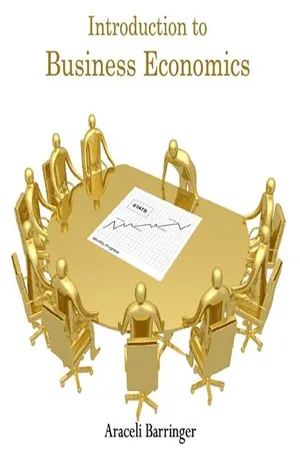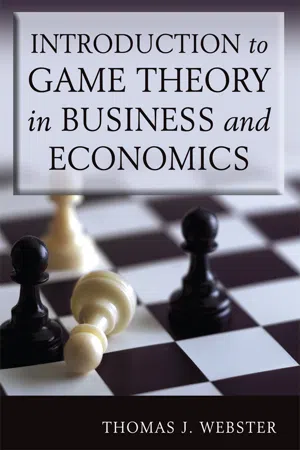Business
Bertrand Oligopoly
Bertrand oligopoly is a market structure in which a small number of firms compete by setting prices for their products. Each firm assumes that its rivals will not change their prices in response to its own price changes. This can lead to price competition and lower prices for consumers, as firms try to undercut each other to gain market share.
Written by Perlego with AI-assistance
Related key terms
1 of 5
10 Key excerpts on "Bertrand Oligopoly"
- eBook - PDF
- Jianwei Huang, Lin Gao(Authors)
- 2022(Publication Date)
- Springer(Publisher)
It is named after Joseph Louis Francois Bertrand (1822–1900). The Bertrand model has the following key features: • There are at least two firms producing homogeneous (undifferentiated) products; • Firms do not cooperate, i.e., there is no collusion; • Firms compete by setting prices simultaneously; • Consumers buy everything from a firm with a lower price. If all firms charge the same price, consumers randomly select among them. • The firms are economically rational and act strategically, seeking to maximize profits given their competitors’ decisions. Similarly, we consider a Bertrand model between two firms, I = {1, 2}. Each firm i chooses the price p i , rather than quantity as in the Cournot model. Consumers buy from the firm with a lower price, and the total consumer demand is a decreasing function of the market price, denoted by D(min{p 1 , p 2 }). In such a competition model, what is the best price choice of each firm? It is important to note that the Bertrand model is a different game than the Cournot model: the strategy spaces are different, the payoff functions are different, and (as will be shown later) the market outcomes in the Nash equilibria of the two models are different. - No longer available |Learn more
- (Author)
- 2014(Publication Date)
- Orange Apple(Publisher)
The study of product differentiation indicates that oligopolies might also create excessive levels of differentiation in order to stifle competition. Oligopoly theory makes heavy use of game theory to model the behavior of oligopolies: • Stackelberg's duopoly. In this model the firms move sequentially. • Cournot's duopoly. In this model the firms simultaneously choose quantities. • Bertrand's oligopoly. In this model the firms simultaneously choose prices. ____________________ WORLD TECHNOLOGIES ____________________ Characteristics Profit maximization conditions : An oligopoly maximizes profits by producing where marginal revenue equals marginal costs. Ability to set price : Oligopolies are price setters rather than price takers. Entry and exit : Barriers to entry are high. The most important barriers are economies of scale, patents, access to expensive and complex technology, and strategic actions by incumbent firms designed to discourage or destroy nascent firms. Number of firms : Few – a handful of sellers. There are so few firms that the actions of one firm can influence the actions of the other firms. Long run profits : Oligopolies can retain long run abnormal profits. High barriers of entry prevent sideline firms from entering market to capture excess profits. Product differentiation : Product may be homogeneous (steel) or differentiated (automobiles). Perfect knowledge : Assumptions about perfect knowledge vary but the knowledge of various economic actors can be generally described as selective. Oligopolies have perfect knowledge of their own cost and demand functions but their inter-firm information may be incomplete. Buyers have only imperfect knowledge as to price, cost and product quality. Interdependence : The distinctive feature of an oligopoly is interdependence. Oligopolies are typically composed of a few large firms. Each firm is so large that its actions affect market conditions. - eBook - PDF
Microeconomics
A Global Text
- Judy Whitehead(Author)
- 2020(Publication Date)
- Routledge(Publisher)
This is understood to be fewer than under the market structure of Monopolistic Competition. • The goal of the firm is to maximize profit. • All factors are freely available to the firm at given prices. OLIGOPOLY C H A P T E R 12 • There is a great deal of interdependence (actual and/or perceived). • The products in the industry may be homogeneous or differentiated. Reasons for oligopoly Typically, oligopoly exists because of: • Economies of scale in production. • Economies of scale in advertising or promotion of the product. • Limited access to raw materials. • Government controls on access to the market (e.g. permit requirements, etc.). • Capital barriers to entry. • Branding and preference barriers or other barriers to entry. 12.1.2 Definitions Classical or traditional oligopoly The term classical oligopoly is used to distinguish the traditional models from the modern or alternative models of the firm introduced since the 1950s. The non-collusive and collusive models listed above are all part of classical or traditional oligopoly. Pure and differentiated oligopoly Under pure oligopoly firms produce a homogenous product (e.g. flour, salt). Under differentiated oligopoly firms produce a differentiated product (e.g. automobiles, refrigerators). These products are usually differentiated by branding. As with Monopo-listic Competition, the differences may be real or fancied. However, they must be such that the consumer perceives the products to be different. 12.1.3 Model summary The various traditional or classical models of oligopoly may be grouped into the two major classes of non-collusive and collusive. The game theory approach to modelling oligopoly in terms of competitors in a game with strategies and counter-strategies may be included among the traditional models. The models may be summarized as follows. Non-collusive models • The Cournot duopoly model • The Bertrand/Edgeworth duopoly model • The Chamberlin duopoly model. - eBook - PDF
Contemporary Industrial Organization
A Quantitative Approach
- Lynne Pepall, Dan Richards, George Norman(Authors)
- 2011(Publication Date)
- Wiley(Publisher)
In addition, high cost firms can survive in a Cournot model of competition—although they will be less profitable than lower-cost rivals. This is not possible in the basic Bertrand model of 168 Oligopoly and Strategic Interaction price competition with identical products. In that case, only the lowest-cost producers can survive market competition. However, the efficient outcome predicted by the simple Bertrand model depends upon two key assumptions. The first is that firms have extensive capacity so that it is possible to serve all a rival’s customers after undercutting the rival’s price. The second key assumption is that the firms produce identical products so that relative price is all that matters to consumers when choosing between brands. If either of these assumptions is relaxed, the efficiency outcome of the simple Bertrand model no longer obtains. If firms must choose production capacities in advance, the outcome with Bertrand price competition becomes closer to what occurs in the Cournot model. If products are differentiated, prices are again likely to remain above marginal cost, and given the fierceness of price competition, firms have a real incentive to differentiate their products. One approach to modeling product differentiation is the Hotelling (1929) spatial model, which we first introduced in Chapter 3. This model uses geographic location as a metaphor for differences between versions of the same product. It thereby makes it possible to consider price competition between firms selling differentiated products. The Hotelling model makes it clear that Bertrand competition with differentiated products does not result in efficient marginal cost pricing. It also makes clear that the deviation from such pricing depends on how much consumers value variety among products. The greater value that the typical consumer places on getting her most preferred version of the product, the higher prices will rise above marginal cost. - eBook - PDF
Intermediate Microeconomics
An Intuitive Approach with Calculus
- Thomas Nechyba(Author)
- 2018(Publication Date)
- Cengage Learning EMEA(Publisher)
By merging product differentiation into the Bertrand model and allowing barriers to entry to be less extreme, we will now develop the model of monopolistic competition . We will see that price gradually converges to the competitive price, this time as entry barriers gradually fall. We will thus have found a way to bridge the gap between the more extreme models with both a quantity setting and a price-setting framework. Which of these is the better model will depend on the underlying economic realities in real-world industries, with the approach developed in this chapter particularly applicable to industries that experience ongoing innovation. 26A Differentiated Products and Innovation We will first look at the implications of moving away from the assumption that oligopolists are producing identical products and instead assume that oligopoly firms produce differentiated products in an attempt to lessen price competition. Copyright 2018 Cengage Learning. All Rights Reserved. May not be copied, scanned, or duplicated, in whole or in part. Due to electronic rights, some third party content may be suppressed from the eBook and/or eChapter(s). Editorial review has deemed that any suppressed content does not materially affect the overall learning experience. Cengage Learning reserves the right to remove additional content at any time if subsequent rights restrictions require it. DIFFERENTIATED PRODUCTS AND INNOVATION 805 26A.1 Differentiated Tastes in Oligopoly Markets Despite its extreme prediction of fierce price competition, the Bertrand model prediction of price equal-ling marginal cost under price competition changes when products are differentiated. At the same time, the Bertrand model often seems more intuitive than the Cournot model in terms of how it defines the strategic variables for firms in oligopolies. - Thomas J. Webster(Author)
- 2018(Publication Date)
- Routledge(Publisher)
Unlike the Cournot model, in which firms decide how much to produce without knowing beforehand the amounts produced by rivals, the Bertrand model assumes that firms set their prices without knowing the prices charged by rivals. While Cournot assumes that the market price is a function of total industry output, Bertrand assumes that output and sales are a function of the prices charged. Bertrand model A static price-setting game in which firms in the same industry cannot subsequently switch strategies without great cost. In the Bertrand model, industry output adjusts to firms’ pricing decisions. The predictions of the Bertrand model depend on whether firms in the same industry produce a homogeneous or a differentiated product. Our discussion of the Bertrand model begins by as-suming that firms in a duopolistic industry face a linear demand for a homogeneous product. We will also assume that both firms are identical and produce at constant marginal cost. Since the firms’ output are perfect substitutes, consumers will buy from the firm charging the lowest price. More specifically, if P i < P j , the demand for firm i ’s product is Q i = Q i ( P i ) and Q j = 0. If both firms charge the same price ( P i = P j = P ), the firms will split the market, that is, Q i = Q j = 1 / 2 Q T . Bertrand-Nash Equilibrium for Homogeneous Products What is the optimal pricing strategy for each firm? Suppose that firm 1 expects firm 2 to set its price above the monopoly price P m ? Firm 1’s best response is to charge the monopoly price. Firm 1 will sell to the entire market and earn monopoly profits. If firm 1 expects firm 2 to charge a price that is below the monopoly price but greater than marginal cost ( MC ), firm 1 will set its price just IMPERFECT COMPETITION 191 below that of firm 2. While firm 1 will not earn monopoly profits, it will earn positive economic profits since P > MC, while firm 2 will sell nothing and earn zero profits.- eBook - PDF
Microeconomics
Theory and Applications
- Edgar K. Browning, Mark A. Zupan(Authors)
- 2019(Publication Date)
- Wiley(Publisher)
• Oligopoly is characterized by a few firms that together produce all or most of the total output of some product. A pronounced mutual interdependence among the decisions of firms in the industry results. • What one firm does has a decided impact on other firms in an oligopoly, but the way that other firms will react is uncertain. • There are three common oligopoly models: Cournot, Stackelberg, and dominant firm. • Oligopoly firms can collude and operate as a cartel. • The variety of models for studying oligopoly and the differences in their implications make generalizing about the effects of oligopoly difficult. In some cases, prices are predicted to be near the monopoly level. In other cases, they hover near the competitive level. • Oligopolistic outcomes lie somewhere between the monopoly and competitive results and differ from one industry to another. SUMMARY Questions and problems marked with an asterisk have solu- tions given in Answers to Selected Problems at the back of the book (pages 532–539). 13.1 What are the assumptions of the theory of monopolistic competition? In what way do these assumptions differ from those of the perfectly competitive model? 13.2 Explain the relationship between the demand elasticity and the excess capacity that occurs for a monopolistic competitor. 13.3 Explain how, in the Cournot model, the output of one firm depends on the output of other firms. Specif- ically, in Figure 13.3, what will be the output of Artesia if Utopia produces 32 units? If Utopia produces 48? If Utopia produces 64? 13.4 Starting from the Cournot equilibrium in Figure 13.3, sup- pose that the marginal and average total cost curves (which are the same for both firms) shift downward. Explain how the firms adjust to a new Cournot equilibrium. - eBook - PDF
Industrial Organization
Contemporary Theory and Empirical Applications
- Lynne Pepall, Dan Richards, George Norman(Authors)
- 2013(Publication Date)
- Wiley(Publisher)
However, the efficient outcomes predicted by the simple Bertrand model depend upon two key assumptions. The first is that firms have exten- sive capacity so that it is possible to serve all of a rival’s customers after undercutting the rival’s price. The second key assumption is that the firms produce identical products so that relative price 13 More recently, C. Taylor, N. Kreisle, and P. Zimmerman, (2010) use an alternative data set that suggests the impact of the merger was to raise prices by much less than the effect found by Hastings (2004). Oligopolistic Price Competition 261 is all that matters to consumers when choosing between brands. If either of these assumptions is relaxed, the efficiency outcomes of the sim- ple Bertrand model can no longer be obtained. If firms must choose production capacities in advance, the outcome with Bertrand price com- petition becomes closer to what occurs in the Cournot model. If products are differentiated, prices are again likely to remain above marginal cost. Indeed, given the fierceness of price compe- tition, firms have a real incentive to differentiate their products. A useful model of product differentiation is the Hotelling (1929) spatial model, which we first introduced in Chapter 4. This model uses geographic location as a metaphor for more gen- eral distinctions between different versions of the same product. It thereby makes it possible to consider price competition between firms sell- ing differentiated products. The model makes it clear that Bertrand competition with differenti- ated products does not result in efficient marginal cost pricing. It also makes clear that the devi- ation from such pricing depends on how much consumers value variety. The greater value that the typical consumer places on getting his or her most preferred brand or version of the product, the higher prices will rise above marginal cost. - eBook - PDF
Intermediate Microeconomics
A Tool-Building Approach
- Samiran Banerjee(Author)
- 2021(Publication Date)
- Routledge(Publisher)
Chapter 13 Oligopoly Just as economists make sense of what happens in competitive markets in terms of the market equilibrium that arises from the interaction of demand and supply, in an oligopolistic equilibrium, the behavior of firms corresponds to that of a Nash equilibrium (NE), i.e., each firm is maximizing its profit given the actions of the others. Oligopolies are usually modeled in one of two ways: firms either choose the quantities they wish to produce ( quantity competition ), or they choose the prices they wish to charge ( price competition ). While the game-theoretic ideas are exactly the ones introduced in Chapter 12, the only difference is that the firms typically choose their actions from a continuum rather than a finite set of discrete options. For instance, under quantity competition, a firm can choose any output ranging from zero to its capacity; under price competition, a firm can charge any price ranging from its marginal cost of production to the maximum price that buyers are willing to pay for it. 13.1 Static Quantity Competition We begin with an example of the classic duopoly model of Augustin Cournot that dates back to 1838 but is still one of the most important ways in which economists think about quantity competition. 13.1.1 Cournot duopoly Two firms produce a homogeneous good. Firm 1 produces quantity q 1 and 2 produces q 2 , so the total quantity produced is Q = q 1 + q 2 . The firms face 242 Oligopoly 243 an inverse market demand given by p = 200 − Q , or p = 200 − q 1 − q 2 . It costs each firm $20 to produce each unit of output. We assume that each firm chooses its own output taking as given the other firm’s production level. Graphical representation One way to find an NE for this problem graphically is to plot each firm’s best-response to the other firm’s output choice and find a point of mutual best-response. To do so, assume that firm 2 has chosen its output level arbitrarily at q 2 . - eBook - PDF
Economic Analysis in Historical Perspective
Butterworths Advanced Economics Texts
- J. Creedy, D.P. O'Brien(Authors)
- 2014(Publication Date)
- Butterworth-Heinemann(Publisher)
This outcome may, of course, be impeded by factors other than collusion. Conditions of exit will be unpropitious if loss-making, inefficient firms can hang on with average variable costs less than the total costs of a potential entrant. Subsidies and protective labour market legislation may create further barriers to exit. Andrews and Brunner (1975) define the industry in terms of firms with similar production processes capable in any given time period of producing a range of products, rather than in terms of product markets and consumer preferences. Since oligopoly is concerned with producer competition this is distinctly helpful. Their analysis of the industry is also realistically dynamic. The boundaries of the industry will be constantly changing, as will its member-firms' positions in individual product markets, as potential competition exerts its pressure. Firms will both supply and compete with each other, and small firms will be potential competitors with units or divisions of large firms. There will not, however, be continual price changes. Competition will work through the fixing of entry-deterring, normal-cost pricing, embellished by a complex mixture of product competition and price adjustment. 5.5.3 OLIGOPOLY, MANAGERIAL THEORIES AND THE GROWTH OF THE FIRM Cross-entry competition implies a model of the firm much closer to the 'new' theories of the firm than the standard textbook exhibit. The 144 Oligopoly and the theory of the firm price-fixing process of an entry-deterring, normal cost oligopolist will surely bear a close resemblance to Baumol's profit-constrained sales revenue-maximizer, if the threat of potential competition, which a sales maximizer is bound to encounter, is built into the profit constraint. If entry-deterrence is taken into account the scope for discretionary expenditures by managers may be significantly reduced (Williamson, 1964).
Index pages curate the most relevant extracts from our library of academic textbooks. They’ve been created using an in-house natural language model (NLM), each adding context and meaning to key research topics.









